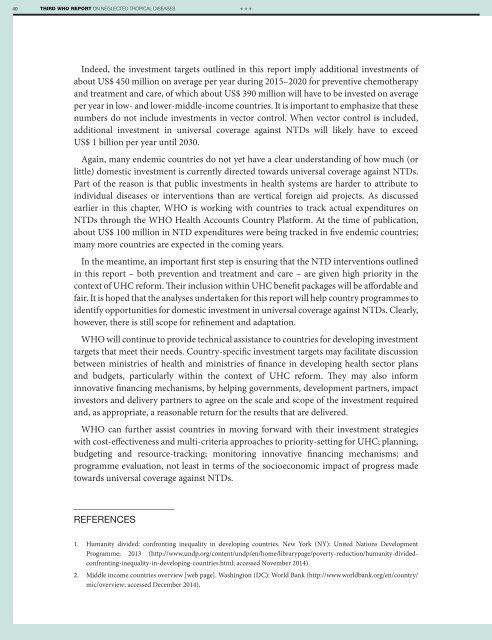1A9bnbK
1A9bnbK
1A9bnbK
Create successful ePaper yourself
Turn your PDF publications into a flip-book with our unique Google optimized e-Paper software.
40 THIRD WHO REPORT ON NEGLECTED TROPICAL DISEASES<br />
***<br />
Indeed, the investment targets outlined in this report imply additional investments of<br />
about US$ 450 million on average per year during 2015–2020 for preventive chemotherapy<br />
and treatment and care, of which about US$ 390 million will have to be invested on average<br />
per year in low- and lower-middle-income countries. It is important to emphasize that these<br />
numbers do not include investments in vector control. When vector control is included,<br />
additional investment in universal coverage against NTDs will likely have to exceed<br />
US$ 1 billion per year until 2030.<br />
Again, many endemic countries do not yet have a clear understanding of how much (or<br />
little) domestic investment is currently directed towards universal coverage against NTDs.<br />
Part of the reason is that public investments in health systems are harder to attribute to<br />
individual diseases or interventions than are vertical foreign aid projects. As discussed<br />
earlier in this chapter, WHO is working with countries to track actual expenditures on<br />
NTDs through the WHO Health Accounts Country Platform. At the time of publication,<br />
about US$ 100 million in NTD expenditures were being tracked in five endemic countries;<br />
many more countries are expected in the coming years.<br />
In the meantime, an important first step is ensuring that the NTD interventions outlined<br />
in this report – both prevention and treatment and care – are given high priority in the<br />
context of UHC reform. Their inclusion within UHC benefit packages will be affordable and<br />
fair. It is hoped that the analyses undertaken for this report will help country programmes to<br />
identify opportunities for domestic investment in universal coverage against NTDs. Clearly,<br />
however, there is still scope for refinement and adaptation.<br />
WHO will continue to provide technical assistance to countries for developing investment<br />
targets that meet their needs. Country-specific investment targets may facilitate discussion<br />
between ministries of health and ministries of finance in developing health sector plans<br />
and budgets, particularly within the context of UHC reform. They may also inform<br />
innovative financing mechanisms, by helping governments, development partners, impact<br />
investors and delivery partners to agree on the scale and scope of the investment required<br />
and, as appropriate, a reasonable return for the results that are delivered.<br />
WHO can further assist countries in moving forward with their investment strategies<br />
with cost-effectiveness and multi-criteria approaches to priority-setting for UHC; planning,<br />
budgeting and resource-tracking; monitoring innovative financing mechanisms; and<br />
programme evaluation, not least in terms of the socioeconomic impact of progress made<br />
towards universal coverage against NTDs.<br />
_____________________<br />
REFERENCES<br />
1. Humanity divided: confronting inequality in developing countries. New York (NY): United Nations Development<br />
Programme; 2013 (http://www.undp.org/content/undp/en/home/librarypage/poverty-reduction/humanity-dividedconfronting-inequality-in-developing-countries.html;<br />
accessed November 2014).<br />
2. Middle income countries overview [web page]. Washington (DC): World Bank (http://www.worldbank.org/en/country/<br />
mic/overview; accessed December 2014).


